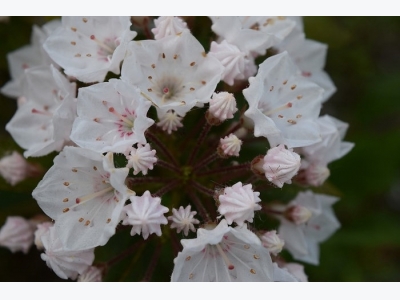How to Grow Mountain Laurel

The mountain laurel (Kalmia latifolia) is a medium-sized evergreen bush also known as calico bush or ivybush.
It is a beautiful native American shrub with glossy leaves and small, star-shaped white and pink flowers. The flowers grow in attractive, eye-catching clusters in mid to late spring.
Mountain laurel is hardy in U.S. Department of Agriculture Hardiness zones 5 through 9. It's average size is 8 feet tall and wide. It is a lovely bush for the outskirts of a woodland garden or as a foundation plant. It is beautiful enough to have earned the State Flower title for the state of Connecticut. Consider using the mountain laurel in place of the later blooming rhododendron. The shape, appearance, and needs of the two shrubs are very similar.
How to Grow and Care for Mountain Laurel
Mountain laurel is easy to grow from transplants. While many plants that you might run across in the wild will not transplant well, young mountain laurels are highly adaptable. Most of us will probably not find one in the wild though, so we'll have to hunt for our mountain laurel at our local nurseries. Mountain laurel tends to sell out early in the season, so plan ahead and beat the crowd. Select a variety that will work well in your region.
Mountain laurel is a sun-loving plant. It will especially appreciate several hours of morning sun and a partially sunny afternoon. If you can plant your shrub where this preference can be met, you will be rewarded with bountiful blossoms.
Once you have selected a sunny site to plant your mountain laurel in, treat it to acidic, well-drained soil. To add acid to your soil before planting, mix peat moss into your soil. Every spring before your mountain laurel blooms, add an acidic fertilizer into the soil in the form of peat moss, compost, or acidic mulches, like shredded bark or pine needles. The mulch will serve dual purposes: it will nourish your plant with the acid it loves and it will maintain soil moisture.
Mountain laurel needs to be watered regularly. The soil can feel moist to the touch at all times, but it will be happy if left a bit dry, too. It would rather be dry than waterlogged.
While pruning isn't a must do, you can prune your mountain laurel to maintain its shape and to encourage flowering for the next season. Timing is everything when pruning this bush, so prune as the flower buds begin to fade away. If the buds are starting to drop themselves, it is too late to prune. You don't want to make the mistake of pruning off the growth buds for next year.
Mountain Laurel Pests and Problems
Mountain laurel is susceptible to the lacebug. This nasty little pest sucks the moisture out of the leaves. The leaves will appear spotted and whitish. Unfortunately, the only way to get rid of a lacebug infection is to treat it with a pesticide. Treat the underside of each leaf if you notice your shrub has succumbed to this pest.
Another problem for mountain laurel is leaf spot. This fungal disease can often be prevented by purchasing a resistant variety and by providing plenty of sunshine and air circulation to your shrub. Prune your branches if that will help it breathe easier. Clean dead leaves away from the base of your mountain laurel, too. This can help to further prevent the spread of leaf spot to other leaves.
Mountain laurel is highly toxic to people and pets when ingested, so keep this in mind as you consider whether or not this shrub is right for you.
Mountain Laurel Varieties to Consider
'Elf' is a semi-dwarf variety with miniature leaf size. The blooms are nearly full size, which gives the shrub a whimsical appearance when in bloom.
'Pinwheel' has a compact form with hardy leaf structure that is resistant to leaf spot. The name is derived from the flowers which have scalloped edges. The center of the flower is white, and the tips are a deep red color which creates a striking contrast.
Related news
 How to Grow Trumpet Vine
How to Grow Trumpet Vine Gardening expert, Michael Dirr has commented that if you can’t grow trumpet vine (Campsis radicans), you might as well give up gardening.
 Garden tips: What to do in your garden in July
Garden tips: What to do in your garden in July Half the year is over, but there’s still plenty of gardening to be done. Here are some things to do this month:
 How to Grow Virginia Bluebells
How to Grow Virginia Bluebells Bluebells were used medicinally by the Cherokee Indians to treat tuberculosis and whooping cough and as an antidote for poisoning.